Re: Along The Gilpin Tramway - The Haverhill Mine.
Posted by Keith Pashina on Apr 01, 2025; 3:07am
URL: http://c-sng-discussion-forum.254.s1.nabble.com/Along-The-Gilpin-Tramway-A-Closer-Look-tp20380p20649.html
The Gunnell Hill Branches to the Mines - continued
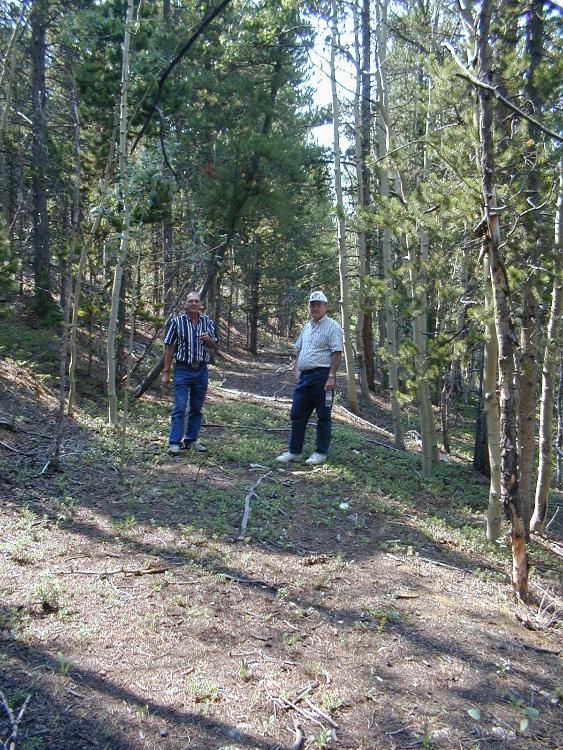
Continuing further up the Gunnell Hill spurs, we find Dan Abbott and Joe Crea exploring the gently-graded spur leading to the Concrete Mine.
M.P. 40.74 Concrete Switchback:
On the north side of the main line, the track began a steep climb on the first of several switchbacks to serve the Whiting, Grand Army, and Concrete mines, and eventually, the Hubert Mine. The Concrete Mine was a major producer. It not only operated its own shaft, but also the nearby Golden Treasure mine workings.
Adjacent to the start of this series of switchback was the Straub Mine, which some records show was periodic tramway shipper. I have no record of a spur being laid directly to the shaft house.
Getting back to the Concrete Mine, the Gilpin Observer newspaper reported on December 29, 1898, that, “…All ore ot small enough to pass through grizzlies after being hoisted to the surface is run through the crusher and conducted by means of a chute to tramway cars standing on a track which is enclosed by an L to the shaft building. Thence it is taken to the stamp mills at Blawk Haw, where it is dumped into an ore house and these passes to automatic ore feeders which are placed in front of stamp batteries.” This was an up-to-date operation, as most mines did not machine-crush ore at the mine, nor did all mills feed the stamp batteries with automatic feeders.
This was a busy mine, too. The Gilpin Observer reported on May 4, 1899, that “…the Concrete Gold Mining company shipped over the Gilpin tramway to the Penn stamp mill in Black Hawk the past month, ending April 30, 180 cars or 1,500 tons of ore.”
By 1902, ore shipments slowed down, the Gilpin Observer reporting on January 2, 1902, “the stamp mill ore output having averaged 25-30 tons per day…”
In 1904, when the Gunnell Mine shaft house burned, the Concrete Mine miners had to temporarily halt work, the Gilpin Observer reporting that there was “too much gas from the fire” at that time. Operations seemed to slow down quickly – the Gilpin Observer reported on 6 miners working the mine on a lease at that time.
There are traffic records showing ore shipments on the tram in years 1898 to 1903. There could be more, it just means there are records existing for those particular periods, and not for other years.
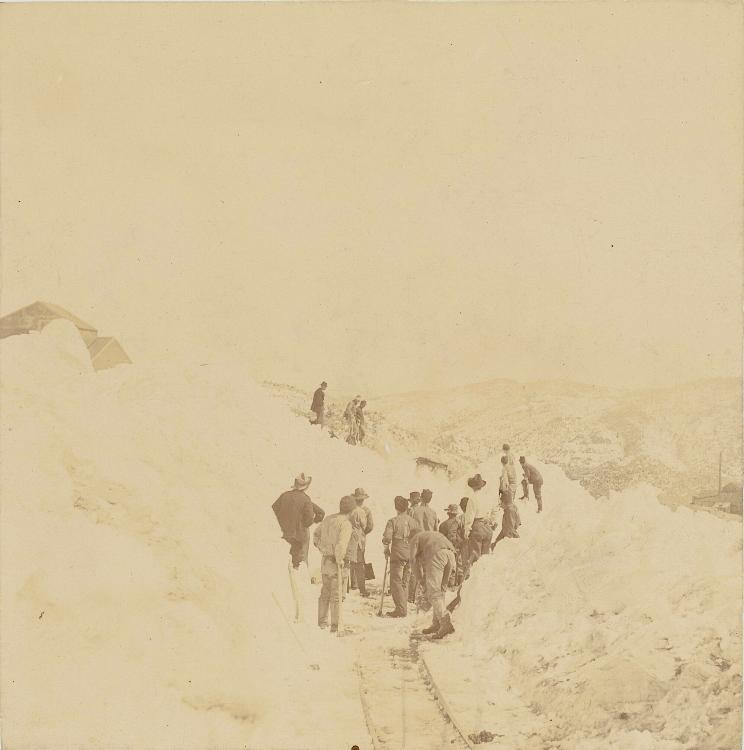
This image, from the Denver Public Library, Western History Collection, Image Z-3491, was taken in 1899 and has been published to show the difficulties in dealing with snow removal. It also shows what may be part of the Concrete mine in the background. Grand Army, Concrete and Hubert mines diverged from the main line. This image is looking northeast.
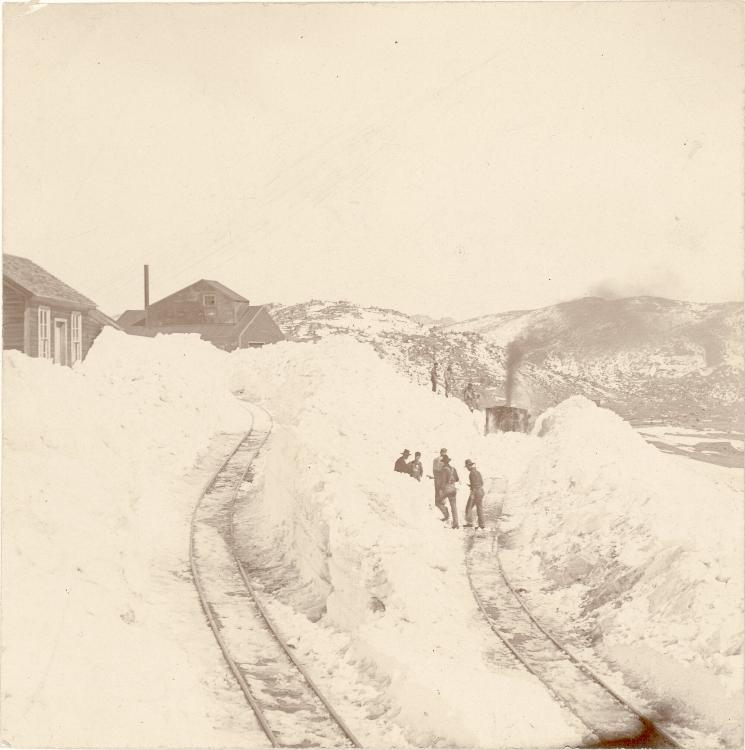
A companion photo, also taken by H.H. Lake, shows that now the track up the Whiting/Grand Army/Concrete/Hubert branch has been at least partially cleared. This photo also illustrates the abrupt change in grade, and curvy nature of the mine spurs. This image, also is from the Denver Public Library, Western History Collection, Image Z-3488.
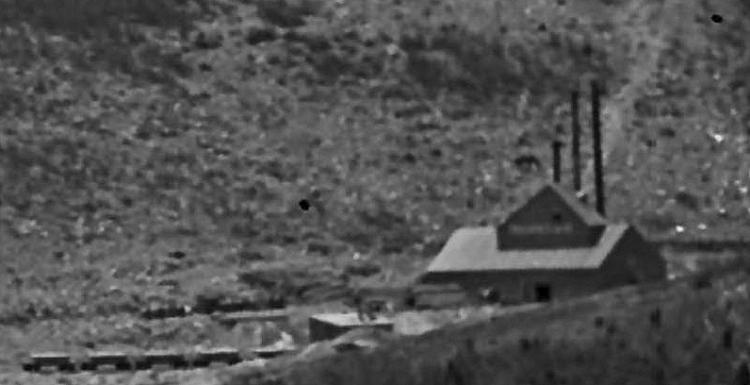
An enlargement of a Denver Public Library, Western History Collection image L-230 shows a busy Concrete Mine, with at least 5 Gilpin Tram ore cars on the spur for ore loading.
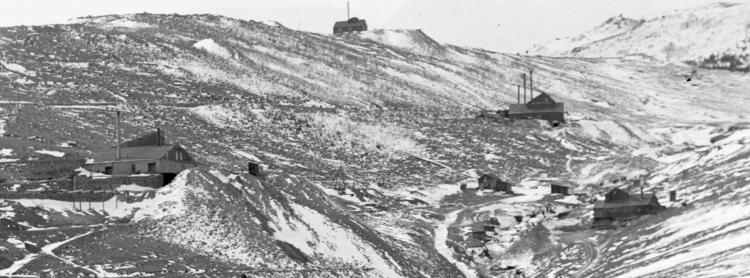
Another photo from the Denver Public Library, Western History Collection, enlarged, shows the Concrete Mine at the center of this image. The Grand Army Mine is at left center, and the Gold Collar Mine at right Center.
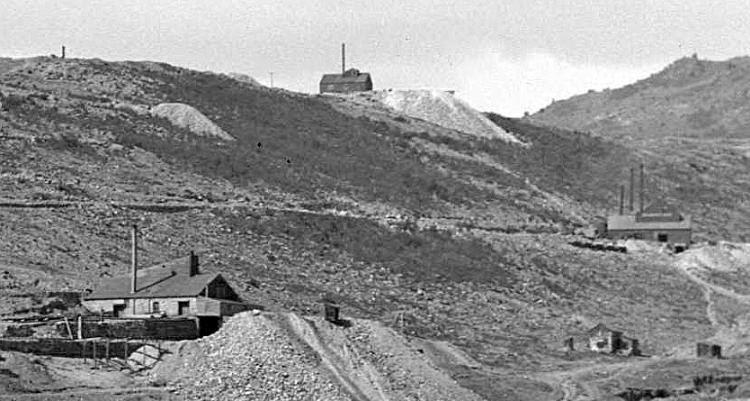
This is from Denver Public Library, Western History Collection, taken in 1899, and shows the Grand Army Mine (lower left) and Concrete Mine at right center. The Gilpin Tram grade to the Concrete Mine can be clearly seen.
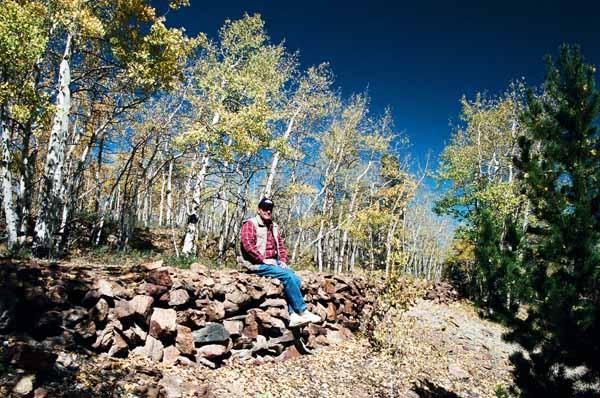
As with so many Gilpin Tram spurs, the spurs to the Concrete Mine and othes were supported on low dry-laid stone walls. Joe Crea is taking a break on the one leading to the Concrete Mine, and shows the general height of one of these walls.
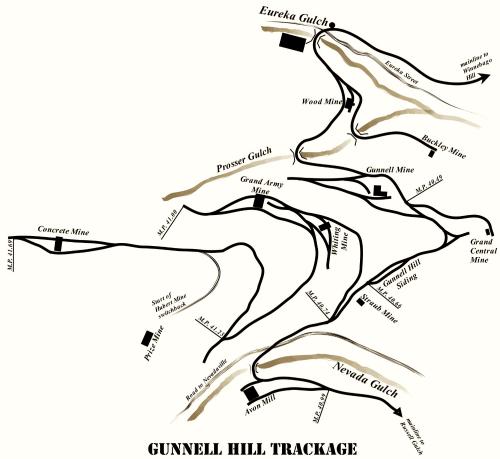
I’m posting this map to orientate us to the network of trackage on Gunnell Hill again. The Concrete Mine is at the left edge of this map.

I overlaid red lines on this photo to denote where Gilpin Tram grade is visible in this photo. The main line passing the Gunnell Mine is the lowest level, at the bottom left corner. Above it are the Whiting and Grand Army mines, and above them, the switchbacks to the Concrete Mine. Even higher up Gunnell Hill is the branch to the Hubert Mine, which is where we’re headed next.
URL: http://c-sng-discussion-forum.254.s1.nabble.com/Along-The-Gilpin-Tramway-A-Closer-Look-tp20380p20649.html
The Gunnell Hill Branches to the Mines - continued

Continuing further up the Gunnell Hill spurs, we find Dan Abbott and Joe Crea exploring the gently-graded spur leading to the Concrete Mine.
M.P. 40.74 Concrete Switchback:
On the north side of the main line, the track began a steep climb on the first of several switchbacks to serve the Whiting, Grand Army, and Concrete mines, and eventually, the Hubert Mine. The Concrete Mine was a major producer. It not only operated its own shaft, but also the nearby Golden Treasure mine workings.
Adjacent to the start of this series of switchback was the Straub Mine, which some records show was periodic tramway shipper. I have no record of a spur being laid directly to the shaft house.
Getting back to the Concrete Mine, the Gilpin Observer newspaper reported on December 29, 1898, that, “…All ore ot small enough to pass through grizzlies after being hoisted to the surface is run through the crusher and conducted by means of a chute to tramway cars standing on a track which is enclosed by an L to the shaft building. Thence it is taken to the stamp mills at Blawk Haw, where it is dumped into an ore house and these passes to automatic ore feeders which are placed in front of stamp batteries.” This was an up-to-date operation, as most mines did not machine-crush ore at the mine, nor did all mills feed the stamp batteries with automatic feeders.
This was a busy mine, too. The Gilpin Observer reported on May 4, 1899, that “…the Concrete Gold Mining company shipped over the Gilpin tramway to the Penn stamp mill in Black Hawk the past month, ending April 30, 180 cars or 1,500 tons of ore.”
By 1902, ore shipments slowed down, the Gilpin Observer reporting on January 2, 1902, “the stamp mill ore output having averaged 25-30 tons per day…”
In 1904, when the Gunnell Mine shaft house burned, the Concrete Mine miners had to temporarily halt work, the Gilpin Observer reporting that there was “too much gas from the fire” at that time. Operations seemed to slow down quickly – the Gilpin Observer reported on 6 miners working the mine on a lease at that time.
There are traffic records showing ore shipments on the tram in years 1898 to 1903. There could be more, it just means there are records existing for those particular periods, and not for other years.

This image, from the Denver Public Library, Western History Collection, Image Z-3491, was taken in 1899 and has been published to show the difficulties in dealing with snow removal. It also shows what may be part of the Concrete mine in the background. Grand Army, Concrete and Hubert mines diverged from the main line. This image is looking northeast.

A companion photo, also taken by H.H. Lake, shows that now the track up the Whiting/Grand Army/Concrete/Hubert branch has been at least partially cleared. This photo also illustrates the abrupt change in grade, and curvy nature of the mine spurs. This image, also is from the Denver Public Library, Western History Collection, Image Z-3488.

An enlargement of a Denver Public Library, Western History Collection image L-230 shows a busy Concrete Mine, with at least 5 Gilpin Tram ore cars on the spur for ore loading.

Another photo from the Denver Public Library, Western History Collection, enlarged, shows the Concrete Mine at the center of this image. The Grand Army Mine is at left center, and the Gold Collar Mine at right Center.

This is from Denver Public Library, Western History Collection, taken in 1899, and shows the Grand Army Mine (lower left) and Concrete Mine at right center. The Gilpin Tram grade to the Concrete Mine can be clearly seen.

As with so many Gilpin Tram spurs, the spurs to the Concrete Mine and othes were supported on low dry-laid stone walls. Joe Crea is taking a break on the one leading to the Concrete Mine, and shows the general height of one of these walls.

I’m posting this map to orientate us to the network of trackage on Gunnell Hill again. The Concrete Mine is at the left edge of this map.

I overlaid red lines on this photo to denote where Gilpin Tram grade is visible in this photo. The main line passing the Gunnell Mine is the lowest level, at the bottom left corner. Above it are the Whiting and Grand Army mines, and above them, the switchbacks to the Concrete Mine. Even higher up Gunnell Hill is the branch to the Hubert Mine, which is where we’re headed next.
Keith Pashina
Narrow-minded in Arizona
Narrow-minded in Arizona
| Free forum by Nabble | Edit this page |